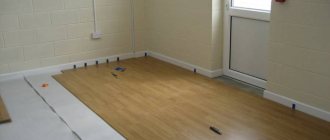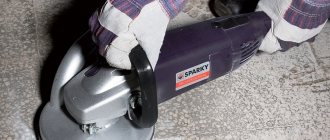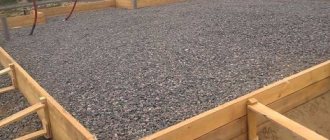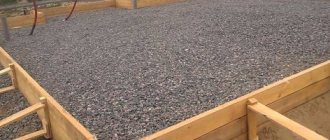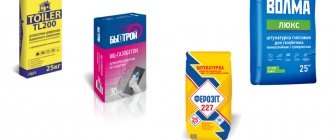In the new apartment, there will be concrete tiles in the bathroom, kitchen and hallway, but there will undoubtedly be laminate in the bedroom and living room. The model has already been chosen, the main thing is not to forget to buy a backing for the laminate. I still don’t understand how they differ and which one is better. But it should compensate for small unevenness, provide play when the temperature and humidity of the laminate changes, but most importantly, insulate noise (I immediately remembered the upstairs neighbor who likes to wear heels).
Why is a laminate underlay needed?
A backing for the laminate is necessary for the material to serve for a long time. Laminate looks quite attractive on the floor and is highly wear-resistant. It is necessary to use a backing, as it is warm and serves as a waterproofing agent.
Additional material is needed for the laminate because panel panels are not a natural product. They are based on wood dust, compressed and covered with impregnated paper. The top layer is a laminated surface. As a result, it turns out that the bottom layer is vulnerable and can fail.
A lot depends on the choice of substrate: the service life of the laminate, its appearance, the microclimate in the room as a whole.
Laying the underlay under the laminate is due to the fact that it helps waterproof the base. The material makes it possible to make the subfloor level and leave a gap of 2 millimeters. If you lay the laminate without such a gasket, you will hear a dull sound when you step on it.
A backing for the laminate is needed to eliminate vibration. It should prevent the laminate floor from loosening. It should also be used as insulation.
If you take the choice of a laminate seriously, you also need to take the purchase of a substrate equally responsibly - a material that many consider auxiliary and even secondary. But the service life of the flooring directly depends on its properties.
The underlay has several functions: it acts as a shock absorber for laminated boards, dampens sounds that occur when walking, and at the same time - penetrating from below. In addition, it serves as a membrane between the subfloor and the finishing coating, providing the necessary microcirculation of air.
It also protects the boards from friction against unevenness of the cement screed, even invisible to the eye. Finally, the right underlay preserves the heat in the room and, most importantly, the appearance and quality of the floor covering.
Several types of substrates available on the construction market differ in their properties and cost. Not all of them are suitable for installation on such a popular heated floor or for use in wet rooms. They also differ in service life.
So, when making a choice, it is necessary to evaluate all the features of the room where the new floor covering will be located. Including the loads that he will have to systematically withstand.
Tuplex and Profitex Uniplex backing with foam beads
Finn told me that they use a backing with white balls. It’s easy to guess that we are talking about the Finnish Tuplex. The truth is now produced in Russia and there are a number of analog insulations that are not inferior in quality. Therefore, it is quite possible to choose based on cost.
Currently produced in a branch located in Russia. Profitex is also manufactured in our country. They completely compete with each other, being in the same price category and using the same technology.
Yandex Market link to Tuplex and Profitex
Yandex Market link to Uniplex (Best price!)
In Leroy Merlin - Domoflex
And in Petrovich there is a KM substrate.
Tuplex and Profitex Uniplex - pros and cons
The technology is patented in Finland and consists of foam balls placed between two high- and low-pressure polyethylene films. The bottom layer is perforated and serves to penetrate residual moisture (if any) from the concrete screed into the cavity between the films.
When moving on the floor covering, pressure is created on the foam granules located inside the Tuplex. The balls disperse moisture vapor with air currents and it comes out through the edges.
Of course, we are talking about a small amount of moisture. No type of substrate should be placed on a freshly poured screed. Either it will rot or mold will form.
This unique system for removing moisture using a breathable bottom layer of film was created in Finland. I really like these two types of backing. They are easy and quick to work with.
In reviews of the backing with balls, there are regularly negative comments that the balls crunch and the backing gets dented.
- It's not the balls that crunch. During installation and careless cutting of the substrate, the film may come off. When laying laminate flooring, it may rustle. If the “sandwich” is not broken, nothing will crunch.
- It is better not to fasten the backing with stationery tape, since if it does not fit tightly, it can also make noise.
- The substrate is dented less than foam and less than polystyrene, but more than pine or cork insulation.
One of the disadvantages is the non-working residue of less than 0.5 m2, located at the base of the bushing. To be fair, it should be said that this defect is also present on the cork backing.
Approximate price of Tuplex and Profitex Uniplex from 110 rubles/m2.
Which is the best underlayment thickness for laminate?
- First of all, you need to find out the factors influencing this indicator:
- coating class;
- area of use and expected loads;
- lamella geometry;
- condition of the base (presence of unevenness, cracks, etc.);
- quality of waterproofing;
- components of the lining itself.
The best option for the average buyer when choosing is to clarify what the laminate manufacturer recommends and give preference to the specified materials, since they are manufactured taking into account the distinctive properties of a particular type of panel.
The thickness of the substrate under the laminate is selected according to the installation and operation conditions of the floor covering. In any case, the rough base must be well leveled. Before choosing, make sure that the differences in the base do not exceed 2 millimeters for every 2 meters. If there is a large load at the gap, this will lead to breakage of the lock.
Laminate underlays level the subfloor. Polyethylene foam products are 2-3 millimeters thick. However, they quickly fail and lead to the formation of backlash. It is better that the laminate backings are not very thick so that the locks do not break. If the thickness of the lining is not high enough, you should not choose polyethylene foam products.
In case of sudden changes in the base base, not only substrates for the laminate are required, but also leveling with cement or plywood. Laying is carried out on polyethylene, and gaskets are laid in the right places. They can also be made of wood.
Underlay for laminate flooring is necessary for proper use of the floor. There are different types, they all have their own advantages and disadvantages. It is worth choosing products based on the condition of the base surface. It is preferable to buy a substrate for laminate that is not too thick, but not too thin.
It is worth remembering that soft underlays are limited in terms of thickness, while when using dense ones this value can be increased.
For example, for polystyrene or polyethylene foam, the optimal recommended thickness is no more than 3 mm.
The cork layer can vary from 2 to 4, but it is better to avoid coniferous substrates, or give preference to 4 mm products. Although they are positioned as universal, their thickness is higher than that recommended for laminate (4-7 mm).
In addition, the thickness of the underlayment and lamellas must be proportionate. For a standard 8 mm laminate, 2-3 mm substrates are suitable, for a reduced laminate (up to 7 mm) - two mm, and for an enlarged one (9-12) - 3-5 mm.
Maximum thickness of underlay for laminate
Many people, when laying laminate or parquet boards, as well as linoleum, wonder what the maximum thickness of the underlay for laminate or other floor covering is. Surely this happens due to incorrect calculations of thicknesses and, as a result, a discrepancy between the same floor height level in different rooms.
To level floors, it is logical to use different thicknesses of underlay for laminate, parquet boards or other floor coverings, with a maximum thickness of 12mm.
When using a thick underlay for laminate or parquet, remember that you must use a specialized modification that meets the technical requirements of the manufacturer of laminate, parquet or other flooring!
The maximum permissible thickness of the substrate for laminate is 6 mm; there is no need to choose more. The optimal thickness is 3 mm, and the minimum is 2 mm.
UNIPLEX Ecoline felt underlay - new insulation for floor coverings
Felt underlay for Uniplex Ecoline floor coverings 3mm thick is a new high-quality product on our market. Unfortunately, it is practically not represented in a wide range of retail stores, but in vain.
Found this background on:
Uniplex on Yandex Market
Uniplex on Ozon
I use this service regularly myself. It’s more convenient for me to use Yandex Market because of free delivery from 700 rubles.
Uniplex is a well-designed underlay for the installation of floating floor coverings, such as laminate, parquet boards. The secret is that felted felt is environmentally friendly and has a high density. This results in minimal shrinkage and has a beneficial effect on the durability of the lock joint.
The rolled film gives the product a neat appearance. It does not emit any odor, unlike low-quality polyethylene, which is regularly offered in chain stores for money or in specialized stores as a gift (for a bunch). It prevents the laminate from penetrating excess moisture from concrete floors.
Moreover, a small possible amount of moisture can dissipate in the felt itself in the air passages between the fibers. In principle, in houses with central heating, any substrate can be laid without film, except, perhaps, on the first floors with damp basements.
Thus, we obtain a technically more complex composite product consisting of several types of material.
Felt backing Uniplex, cork, pine - comparison
Uniplex felt underlayment is closest in performance to cork insulation.
- Felt and cork have excellent sound absorption, that is, they dampen impact noise. But cork with a thickness of 2 mm loses, and 3 mm is more expensive and costs about 300 rubles / m2 versus 200 rubles for felt. Due to its high hardness, coniferous insulation reflects impact noise (the sound of footsteps) and creates a drum effect in the room.
- Uniplex with pine needles is superior in structure to cork in terms of insulating sound waves (voices, music).
- It is more convenient to lay a cork lining, although half a meter from each roll cannot be used. Also, from time to time it is overdried and breaks during installation. Felt insulation is difficult to cut; scissors must be used. When laying the needles according to the instructions, it takes a lot of time.
- The most hydrophobic material in this case is pine insulation. Cork is practically not afraid of moisture - tested. Uniplex is made from recycled fabric, so you don't have to worry about a little moisture.
- I would give the best leveling ability to felt insulation. It will fill small irregularities and chipped concrete well. If the base is flat and plywood or the self-leveling floor is well made, you can use felt or cork. If the base is uneven with significant holes, use pine needles on old parquet (it will create the plane required when laying laminate flooring)
- None of these underlays will significantly increase sound insulation from noisy neighbors below. There is always noise from above. For this purpose, comprehensive sound insulation of the screed and walls is carried out. But the drum effect is absorbed by the Uniplex felt backing.
Conclusion
I recommend purchasing Uniplex Ecoline underlay. It is definitely better than pine insulation and comparable to 3 mm cork insulation. But the cost... for now... is one and a half to two times cheaper.
How to lay underlay for laminate
- Correct laying of the substrate under the laminate with your own hands can be done if you have the following materials and tools:
- hammer;
- wedge for spacers;
- sharp device for cutting material;
- polyethylene film as a layer between the substrate and the concrete base;
- ruler, pencil or marker for marking;
- wooden beam;
- engineering tape.
When choosing tools for work, it is very important to consider the type of substrate being laid.
- Algorithm for installation:
- preparation of the subfloor with elimination of existing defects and leveling;
- laying a waterproofing and thermal insulation layer;
- installation of purchased material (substrate);
- installation of laminated flooring.
Let's look at how to properly lay the underlayment under the laminate in stages.
If there are significant surface defects, it is recommended to pour a cement-sand screed over it. Professionals who will take responsibility for all stages of the work - from the purchase of materials to the correct mixing of the solution and pouring in compliance with the technology - will help to carry out the work efficiently.
Further work is performed as follows. After leveling or cleaning, the base is checked for cracks, chips and other defects. They are sealed using the same solution or regular putty. A waterproofing film is placed on top with edges of cut sheets on top of each other and on the walls (up to 15 centimeters high).
The permissible thickness of the substrate should not exceed 4 millimeters. The optimal value is 2-3 millimeters. Two-layer installation is not allowed.
Rolls of backing are rolled out in the direction of laying the laminate. The strips are glued together with a special mounting tape. The substrate is not attached to the floor and walls.
The question arises about which side to put the substrate under the laminate if slabs are used. It is correct to lay the smooth part towards the top.
If the material has a layer of foil, then it should also face up to retain heat in the room and increase the efficiency of underfloor heating, if any. The slabs are also taped and not secured to the base.
Adviсe
- In addition to which side to lay the substrate under the laminate, there are other practical tips:
- The material should be located perpendicular to the walls.
- There should be no gaps or cracks in the substrate throughout the entire area of the room. The entire space enclosed by the walls must be covered with the selected material. The installation technology must not be violated.
- Materials that are too thick should not be used, as they have shock-absorbing properties. Installing heavy pieces of furniture and appliances on a floor with such a layer of underlay will cause deformation of the laminated panels.
Surface preparation
Before choosing a substrate, it is necessary to prepare the surface of the concrete floor . The very first and most important thing is leveling the concrete floor. If you lay the material on an uneven floor, it loses its functionality:
- laminate panels will begin to sag under increased load;
- the seams between the panels may come apart;
- the boards will begin to creak;
- Possible swelling of the coating.
Another important feature that can harm laminate flooring is increased humidity, which can penetrate from under the screed. This is why you need to carefully seal cracks in cement floors.
There are two optimal options for leveling a concrete floor: cement-sand screed and self-leveling mixture.
So, when we have the ideal laminate floor ready, we can safely begin choosing the underlay.
Advice! If you made a screed, then you need to wait as long as possible so that all the moisture evaporates. You can check this in the following way: place a glass jar with the neck down; if after 10 hours there is no perspiration, you can start working.
What is the best underlay for vinyl laminate flooring?
Good options: Axton, Izoplat, Teplon, Arbiton, Tuplex, Izolon, Isopolin, Parcolag, Plenex, Cork. The last of the options mentioned is a cork backing for the laminate. Plenex is the most affordable type of protection. The required qualities are achieved thanks to manufacturing technology - extruded polyethylene.
Plenex is still used along with more effective interlayers (expanded polystyrene/polystyrene, material with foil), as it provides hydro- and thermal insulation.
The underlay for laminate protection from the manufacturer Izoplat is a completely safe option. It is made from pine wood. Accordingly, Izoplat is a coniferous option. This option is not elastic.
And the minimum thickness of the Isoplat plate is 5 mm. The Arbiton analogue belongs to the group of professional products. Foamed polystyrene is used to make it.
Izolon is a backing for laminate, equipped with foil. This option, in addition to the basic properties that foam polyethylene is characterized by, is also distinguished by its vapor barrier properties. But Teplon is a sheet material; polystyrene is used in its production.
The analogue of Tuplex and Parkolag are produced using different technologies: in the first case, the main material is polyethylene, in the second, cork chips. But these options are similar in properties: the substrate under the laminate provides heat, sound and vapor insulation.
Among the variety of designs, there is also a protective accordion layer. From the name you can guess what form of release the product is. But this option is less popular today.
Based on the information collected, taking into account the recommendations of leading laminate manufacturers of the most famous brands - Quick Step, Egger, Tarkett, BerryAlloc, Par-Ky, Haro, Karelia-Upofloor, we have identified the best underlays in different groups in a kind of rating.
The best natural substrates:
| Name | Price, m² | Advantages | Description |
| Premium Cork, Portugal | 90 rub. (2 mm) 145 rub. (3mm) | Natural cork, highest density, lowest thermal conductivity. | The material is “technical cork” made from compressed cork tree bark. It has great resistance to deformation, good noise and vibration absorption, and excellent thermal insulation properties. Installs exclusively on thick film. Sold in rolls and sheets. Not recommended for heated floors. |
| PARCOLAG (Parkolag) | 95 rub. (3mm) | Bitumen-cork, best characteristics. | Ventilated backing. It is kraft paper impregnated with natural bitumen with natural cork topping (granules 2-3 mm in size). It is characterized by high noise absorption, excellent noise and moisture insulation. Roll material. |
| Isoplaat | 55 rub. | Better thermal insulation, acoustics, alignment. | Fiberboard based on coniferous resins for sound insulation. Levels uneven subfloors up to 4 mm. It is characterized by high thermal insulation, natural ventilation, and vapor permeability. Effective damping of “impact” noise, sound dispersion, moisture resistance. |
The best extruded polystyrene substrates:
| Name | Price, m² | Advantages | Description |
| VTM, IsoPolin (Isopolin) | 55 rub. | The best price-quality ratio. | Material: polystyrene film. This rigid structured XPS underlayment falls somewhere between cork and polyethylene in terms of installation complexity and cost. Excellent sound insulation, minimal moisture absorption. Excellent thermal insulation properties that are maintained at high humidity. |
The best polyethylene substrates:
| Name | Price, m² | Advantages | Description |
| Tuplex | 99 rub. | The most technologically advanced. | An ultra-modern composite material consisting of polystyrene foam granules between two layers of polyethylene of different thicknesses. It has excellent moisture and sound insulation properties. The membrane structure of the lower layer of Tuplex allows you to ventilate the space under the laminate: moisture seeps inside and then is discharged under the baseboards. |
| Izolon PPE | 35 rub. | The cheapest substrate. | Heat-resistant, finely porous substrate made of foamed “cross-linked” PPE. Surpasses NPE in all respects. |
| Foil Izolon PPE | 56 rub. | Foil. | Insulating substrate Izolon PPE with a layer of foil 14 microns thick applied to one side. |
The cost can vary greatly: from 14 to 145 rubles/sq.m. m. At the same time, the price is influenced by the quality of the coating, which consists of the degree of reliability of the material, its hygroscopicity, as well as heat and vapor barrier qualities.
When deciding how to choose a subfloor for laminate flooring, service life is also taken into account. At the same time, a well-known brand does not always guarantee long-term operation. To determine how long a laminate flooring protection underlay will last, you need to rely on the type of material.
Combined materials
In addition to traditional materials, manufacturers produce a variety of combined substrates from several components. The goal of these developments is to combine positive qualities and neutralize the shortcomings of individual components. One of the options is Tuplex - a composition of two layers of polyethylene film, between which is a layer of foam balls. The bottom film is perforated to prevent condensation from appearing under the coating. Such substrates are elastic, have good leveling and ventilation properties.
Regardless of what type of material is chosen for the substrate, simple rules should be followed when laying it. The sheet substrate should be spread in a checkerboard pattern, eliminating the formation of gaps between the sheets and avoiding overlapping joints. It is necessary to avoid matching the seams of the substrate and the joints between the laminate lamellas. The joints are fixed with construction tape. For foil materials, aluminum tape should be used.
If the substrate material is chosen correctly and laid correctly, a laminate floor will not cause any inconvenience and will last for decades.
